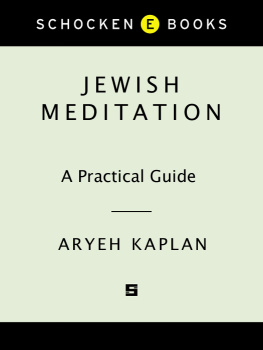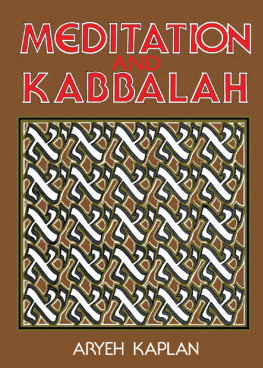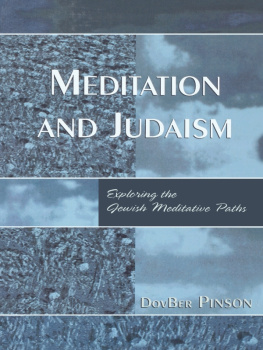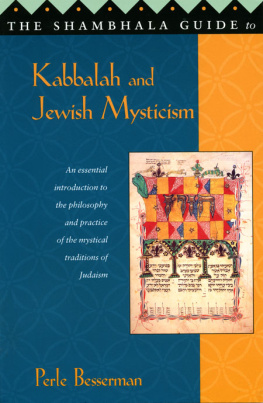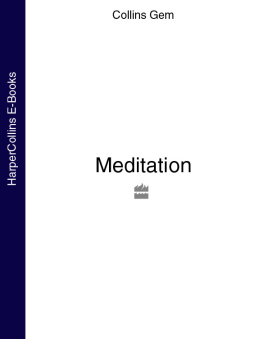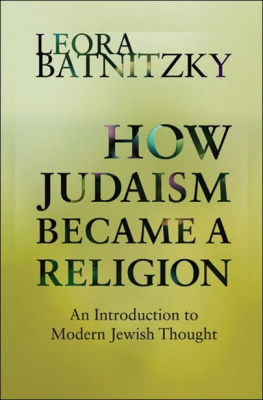O THER S CHOCKEN B OOKS
OF R ELATED I NTEREST
THE MYSTIC QUEST
An Introduction to Jewish Mysticism
by David S. Ariel
0-8052-1003-2
GENESIS AND EXODUS
Translated with Notes and Commentary
by Everett Fox 0-8052-0994-8
ENTERING JEWISH PRAYER
A Guide to Personal Devotion and the Worship Service
by Reuven Hammer
0-8052-1022-9
THE SCHOCKEN GUIDE TO JEWISH BOOKS
Where to Start Reading About Jewish History,
Literature, Culture, and Religion
Edited by Barry W. Holtz
0-8052-1005-9
ON THE KABBALAH AND ITS SYMBOLISM
by Gershom Scholem
0-8052-0235-8
ON THE MYSTICAL SHAPE OF THE GODHEAD
Basic Concepts in the Kabbalah
by Gershom Scholem
0-8052-1008-3
Available at your bookstore or call toll-free:
1-800-733-3000 (credit cards only).
1
WHAT IS MEDITATION?
W hat is meditation? For someone who has been involved in the practice, the question need not be asked. For a person who has never had any contact with meditation, however, the subject is shrouded in mystery. To many people, the term meditation suggests an image of someone sitting in the lotus position with eyes closed in serene concentration. Others may associate meditation with holiness and spirituality. Individuals seeking spirituality might look into various disciplines of meditation without having any idea of what they are looking for.
In its most general sense, meditation consists of thinking in a controlled manner. It is deciding exactly how one wishes to direct the mind for a period of time, and then doing it.
In theory this may sound very easy, but in practice it is not. The human mind is not a domesticated animal, but rather seems to have a mind of its own beyond the will of the thinker. Anyone who has ever tried to concentrate on a subject, only to have his mind drift to other thoughts, is aware of this. Sometimes it seems that the more one tries to control ones thoughts, the more they refuse to be controlled.
It is strange that most people have never given a thought to their thoughts. Thoughts are so much part of our being that we take them for granted. One of the first steps in meditation is learning how not to take our thoughts for granted.
A simple exercise will demonstrate how difficult it is to control your thoughts. In theory this exercise seems ridiculously simple, but in practice it is tantalizingly difficult.
This is the exercise: Stop thinking.
Normally, when one is not otherwise occupied, there is a constant flow of thought passing through the mind. In this reverie, one thought flows into another, almost automatically. This flow of thought goes on and on, like an internal conversation with oneself. Usually, this reverie is so much part of our mental environment that we do not pay attention to it.
The first exercise is to become aware of your thoughts by trying to stop them. Try to blank out your mind for a few minutes and not think of anything at all. Sound easy? Stop reading now and try it.
All right. How long did it last? Unless you are very unusual, or have had meditative experience, you could not keep your mind blank for more than a few seconds. If nothing more, the period of mental silence was probably interrupted by the thought, Im not thinking, or Im trying not to think. In practice, it is extremely difficult to turn off thought. As we shall see, control over the thought process is one of the goals of some meditative disciplines.
There is another way in which you can try to control your mind. When you finish this paragraph, close your eyes. You will probably see lights or images flashing before your eyes. Give yourself a few moments to relax, and these flashing lights will subside and develop into a series of kaleidoscopic images in the minds eye. These images will arise and change spontaneously with little or no direction by the conscious mind. One image flows into another as still another grows and develops. It is almost impossible to concentrate on these mind-begotten images, because when you try, they disappear.
Now, with your eyes closed, try to control these images. Try to depict the letter A in your minds eye. Unless you have practiced this technique for some time, it is impossible to hold on to this image.
One of the techniques of meditation is imaging, evoking an image in the minds eye and holding it there. In Jewish meditation, this is known as engraving. Here the image is fixed in the mind as if it were engraved, so that it can be held in the mind as long as one desires. This technique can be perfected only through extensive training.
Having tried these two exercises, you can see that the mind has a mind of its own. There are thus two parts to the mind, one that is under the control of the conscious will and one that is not. That part of the mind under the control of the will is called the consciousness, while that which is not is called the unconscious or subconscious. Since the subconscious is not under the control of the will, one cannot control what it passes into the conscious mind.
One of the goals of meditation, then, is to gain control of the subconscious part of the mind. If one were to succeed, one would also gain a high degree of self-mastery. This, too, is a goal of meditation.
This explains why so many disciplines use breathing exercises as a meditative device. Breathing usually occurs automatically and is therefore normally under the control of the unconscious mind. Unless you are consciously controlling your breathing, it will mirror your unconscious mood. This is one reason why breathing is one of the indicators in a lie detector test.
Yet, if you wish, you can control your breath, and do so quite easily. Breathing therefore forms a link between the conscious mind and the unconscious. By learning how to concentrate on and control your breath you can go on to learn how to control the unconscious mind.
The thought process itself is also controlled to a large degree by the unconscious, but it can also be controlled by the conscious mind. This is most obvious in the case of the reverie. When one is relaxing and not paying particular attention to it, the reverie flows from one thought to another without conscious effort. Indeed, there are a number of psychological techniques that try to imitate this free association, in order to gain an understanding of the unconscious mind. However, no matter how free the association may be when one is expressing it to a second party, it is never as free as in the case of pure reverie. The reverie thus can also be seen as a point of interface between the conscious and unconscious. By learning how to control the reverie, one can also learn how to control the unconscious.
The same is true of the visions that appear in the minds eye. Since they are not under the control of the conscious mind, they are obviously coming from the unconscious. Controlling them is very difficult without practice; one can learn to control them, however, and doing so also serves to form a bridge between the conscious mind and the unconscious.
One of the most powerful benefits of meditation is control over the unconscious mind. One learns to use the conscious mind to control mental processes that are usually under the control of the unconscious. Gradually, more and more of the subconscious becomes accessible to the conscious mind, and one gains control of the entire thought process.
Sometimes, different parts of the mind appear to be acting independently. The conflict between two parts of the mind can be so strong that a person feels like two separate individuals. During such inner conflict, it seems that one part of the mind wants to do one thing, while the other part wants to do something else.

